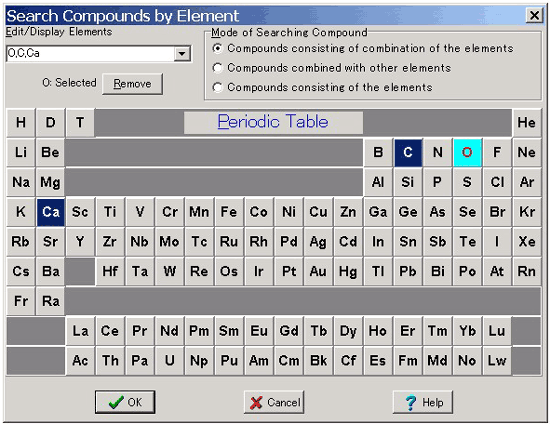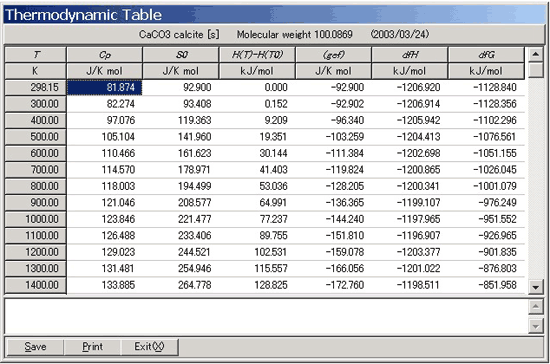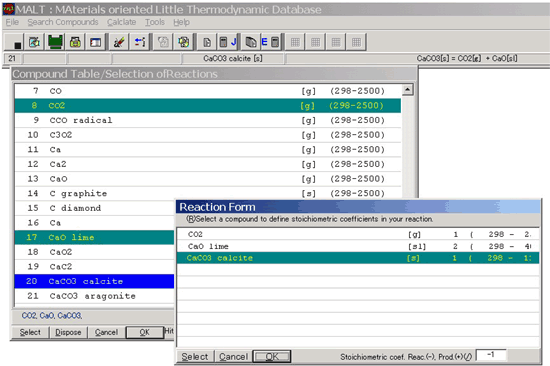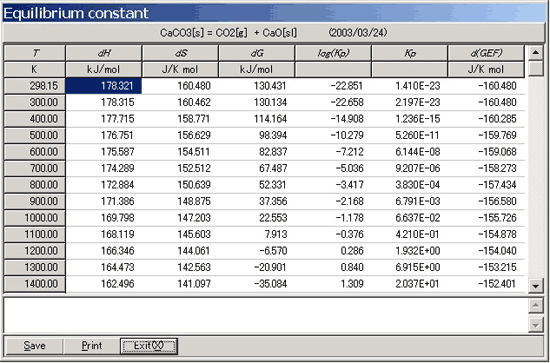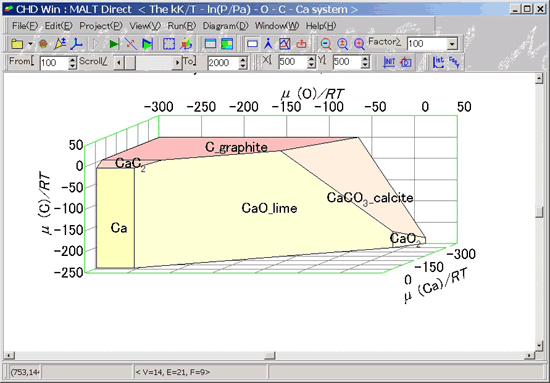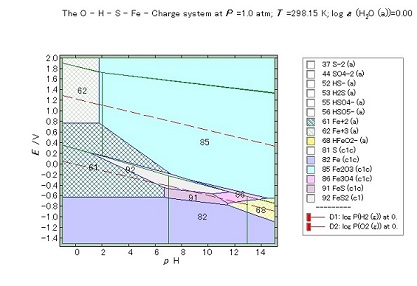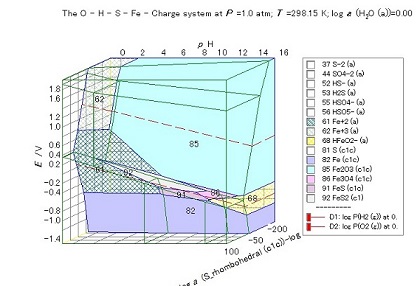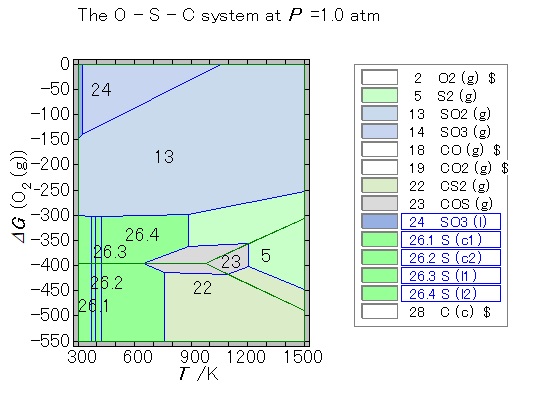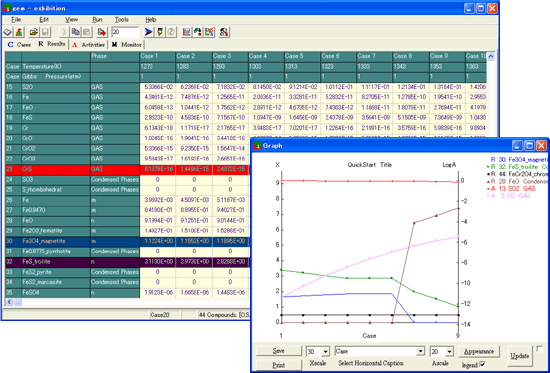Thermodynamic Database MALT Omega / Basic
MAterials-oriented Little Thermodynamic Database
|
MALT was initially developed for chemists researching high-temperature materials. The number of compounds has been greatly increased, and a significant number of aqueous species have been newly added in the Omega version. |
| CHD | Chemical potential diagram |
| gem | Muti-components chemical equilibrium calculation |
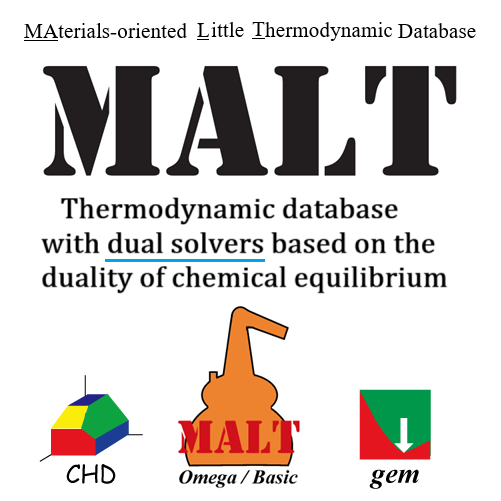
| Written by MALT Group | ||
|
||
| Published by Kagaku Gijutsu-Sha |
| Search within MALT |
| - Omega compound list (7890 species) |
| - User data can be registered. |
| - Basic compound list (4930 species)=the above Omega list without the new items |
| - User data can be registered. |
| - What is Chemical Potential Diagram? |
| - How is Pourbaix Diagram constructed? |
| - Example diagrams of CHD |
| - Advanced Usage |
| - An example of gem calculation |
| ---------------- |
| - In an educational institution, students in the lab are allowed to use the software. |
|
MALT for Windows has been sold to many researchers and engineers in a variety of fields since 2003, with a greatly upgraded version (Omega)
and the revised consumer version (Basic) was released in 2025.
The MALT Omega database has been widely enlarged, and aqueous species have been added. --->The list of compounds (7890 species)
The MALT Basic database retains the same compounds as MALT for Windows, excluding the new items listed above (4930 species).
A part of the data is revised. --->List of Updated Compounds in Old MALT Database Help documents of both versions are fully supplied (online/PC local). You can read them as a whole or on-demand articles.
Chemical Potential Diagram (CHD) and Gibbs Energy Minimizer (gem) are common in Omega and Basic versions. |
|
Chemical thermodynamic data Enthalpy change Gibbs energy change for formation Entropy at 298.15 K Heat capacities Enthalpy change for phase transition |
|
The major objectives of MALT thermodynamic database are
For those purposes, the followings can be made:
(1) Preparation of thermodynamic data for the compound system
The MALT database contains many compounds and species. Even so, it is insufficient for detailed thermodynamic analyses. This makes it necessary for users to check the validity and coverage of the data stored in the MALT database, to compare with other available data, and finally to obtain the best combination of compound data. The MALT users can register their own data. For such a purpose, it is also required to have a good facility for checking the consistency among the thermodynamic data of several different compounds. Given this, it is highly recommended to make use of advanced software in order to examine the equilibria associated with targeted compounds. (2) Analysis based on one chemical reaction
This is one of the fundamental thermodynamic analyses. This is quite simple, but it is most important in many fields such as materials science or chemical process analysis.
The thermodynamic table provides the normal high-temperature properties, such as heat capacity, entropy, and relative enthalpy.
Gibbs energy function, the enthalpy change for formation, and the Gibbs energy change for formation at selected temperatures. The thermodynamic properties change for a chemical reaction can also be tabulated at selected temperatures. When the results of gem or CHD are reconsidered by analyzing in more detail the extracted chemical reaction, it becomes clearer from the physicochemical point of view. In particular, the redox nature or the acid-base relation can be seen behind the chemical reaction, leading to a correlation between what happens and is observed and what is known from the physicochemical nature. (3) Analysis based on the Gibbs energy minimization method
When temperature, pressure, and the initial amount of chemical reactions are given, the corresponding equilibrium amount and associated chemical potential are given for the respective species involved in equilibrium. This is particularly convenient for the multicomponent system in which several chemical reactions can proceed simultaneously. The Gibbs energy minimization under constant pressure or the Helmholtz energy minimization under fixed volume can be made in a series. The latter makes it possible to make calculations for the system under the selected conditions characterized by the constant chemical potentials. For example, equilibria in air are quite important in many industrial processes. The equilibria as a function of oxygen potential are also important in high-temperature fuel cells. In a series of calculations, the amounts of reactants can be determined from the reaction products in the previous calculation. This makes it possible to calculate the time-dependent change in composition of those materials that are exposed under a flow of gases containing some reactive impurities. In a long reaction tube, the changes in substances in the tube can be evaluated under the condition that the gases are in equilibrium with the substance at a point and then equilibrated gases flow to the next point to react with the substance at that point. This is a strong tool in the thermodynamic analyses for the practical situations of materials science or chemical processes. Since the unique solution can be given for the specified conditions, the results are quite understandable and are easily applied to other further considerations. It is therefore crucial to be familiar with handling gem software in the thermodynamic considerations. As described above, it is also essential to extract the most important chemical reaction out of a huge amount of results produced by this software. This makes it useful for users to understand the phenomena occurring on materials or chemical processes from the physicochemical reasons.
(4) Analysis based on the Chemical potential diagram See What is Chemical Potential Diagram? for further details.
The chemical potential diagram is constructed on the basis of the Gibbs phase rule.
In the ternary system at fixed temperature and pressure, three-phase coexistence gives no freedom, so that the chemical potentials of all elements are uniquely fixed and as a result,
the chemical potential of other species/compounds can be uniquely determined. This state corresponds to the point in the chemical potential space. From this equilibrium point, three lines are extended; those are the two-phase coexistence equilibrium. Those geometric features can be plotted to construct the chemical potential diagram having two axis values. Usually, those axis values are selected among the environmentally controllable properties such as temperature, log p(O2), log p(CO2), etc. Even so, more general variables can be adopted as the variables. This is a so-called generalized chemical potential diagram. CHD is a strong tool for constructing the generalized chemical potential diagrams using the powerful polyhedron algorithm. This makes it possible to construct the high-temperature stability diagrams as well as the Pourbaix diagrams by the same software. In addition, the profile diagram is also constructed to show the variation of the partial pressure of the gaseous species or the logarithmic activities of the aqueous species along the fixed line in the diagram. The Pourbaix diagram is newly prepared in the recent version up procedure. Since the special treatments are needed to construct the Pourbaix diagram, the default settings are widely adopted when CHD is run for the chemical system that contains aqueous species. For example, temperature is fixed at 298.15 K since the availability of aqueous data is best at 298.15 K. The fixation of H2O(l) at activity of unity is adopted together with the adoption of pH and E/V as axes. In the multicomponent O-H-X-M system, the element of M is selected as the target element according to the order of the NBS table, when the NBS order of M is higher than that of X. In the <O,H,S,Fe> or <O,H,P,Fe> system, the element Fe is selected as target, while in the <O,H,Fe,Ti> or <O,H,Fe,Na> system, the element Fe will not be selected as target.
(5) MALT Direct - User's Program
MALT suggests that users write their own programs and make their own analyses of their problems. For this purpose, several sample programs written in Delphi are prepared to
show how user programs can be written to utilize the MALT-supplied procedures for handling thermodynamic data. To transfer the thermodynamic data in the MALT to the User's programs,
the special function of "MALT Direct" is prepared. In the MALT-related software, gem and CHD make use of the same MALT Direct function to receive the data
from the MALT Data Management System. Detailed Explanation of Data
Considered matters: Focused Compounds/Properties |

